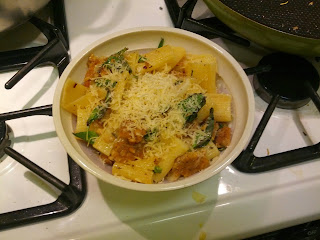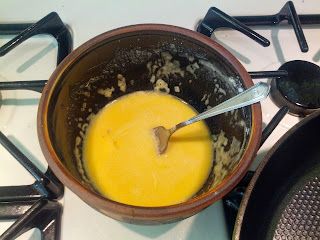A cuisine unto itself. A form of art subtler than electronica and louder than oil painting. A way of salvaging leftovers.
As anyone with any sense will attest, this is the best thing to do with leftover rice. I usually use basmati rice, which apart from having a nice flavor seems well suited for turning into fried rice because the grains tend not to stick together as much as other varieties, and they hold their texture pretty well when cooked multiple times.
Let's start with the archetypal fried rice. If you get this one down, you can make any kind of fried rice and it'll be amazing.
Archetype
Rice, garlic, ginger, eggs, onions, scallions, rice vinegar, soy sauce, high heat vegetable oil
No proportions since that wouldn't be in the spirit of fried rice. Add everything to taste, or according to how much you have.
1. Heat a pan and add the oil.
2. Beat the eggs, and cook this briefly, then set aside. I like to not disturb them so they'll turn into a pancake shape that I can cut into even pieces, but it's not a big deal if you just want to scramble them.
3. Before doing anything else, if necessary, remove stuck spots on the pan and add more oil.
4. Add the ginger and onions, cook until the onions are translucent, or longer if you want them to be sweeter.
5. Add the garlic and cook for another minute, or until it's fragrant but not yet turning brown.
6. Add the rice, and soy sauce. I find pouring the soy sauce onto the rice blobs (assuming the rice is stuck together) works best. For quantity, err on the conservative side. If the rice is really dry, you might also add some water (hot is better), but don't add too much or the rice will turn into mush. It's also easy for the rice to stick, especially if there's not enough liquid or oil. Break up the rice quickly and stir it so it all gets coated in oil. To do the breakage, crushing the blobs with a spatula is effective.
7. Add a dash of vinegar, and the eggs (optional: add a bit of sesame oil). Cook for another half minute, or until the vinegar stops overwhelming all the other smells.
8. Add the scallions, and cook for 20 seconds or until they're fragrant.
This archetype is a helpful way of thinking about the roles of ingredients, and figuring out when to add them and how long to cook them. These roles are roughly as follows:
Egg: Needs to be cooked beforehand, then set aside to be added later. Similar: tempeh, eggplant.
Onions: Source of sweet. Long cooking time, lots of surface area and water. Similar: peppers, zucchini, mushrooms.
Garlic: Medium cooking time, loses fragrance if cooked too long.
Ginger: Long cooking time, high heat. Added directly to hot oil at the beginning. Similar: chili pepper / flakes.
Scallions: Very short cooking time, added right before serving. Similar: basil, cilantro.
Soy sauce: The main source of salt and liquid. Joins the flavors of all the other ingredients and gets absorbed by the rice. Similar: fish sauce, saltwater.
Rice vinegar: Source of sour. Burns if cooked too much. Similar: black vinegar.
Tomato: This isn't in the archetype, but I think it's in its own category. These add lots of water and balance out the other flavors, but they shouldn't be cooked as long as onions. Usually you would add them either right before or right after the rice. Other examples: enoki mushrooms, spinach and other greens.
Almost anything else you can add takes the place of one of these.
Catalog
Ingredient roles in parentheses.
1. Dill (scallions), zucchini (onions), enoki mushrooms (tomatoes), the white part of the scallions (garlic), rice, garlic, ginger, soy sauce, rice vinegar.
2. Tempeh (eggs), poblano pepper (onions), garlic, shungiku (春菊) (tomatoes), soy sauce, black vinegar.
var. 2

















































